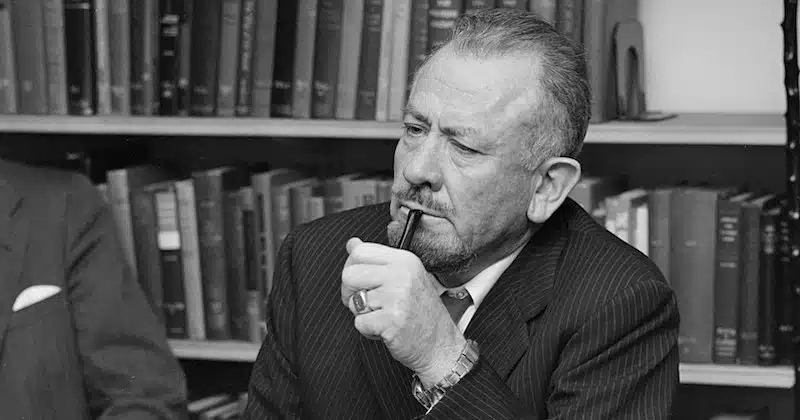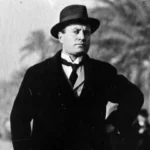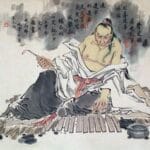Get ready to dive into the fascinating world of John Steinbeck, the legendary writer whose stories have kept readers spellbound for generations. We’re going to dig into some juicy details about this American literary icon. From his strange habits to the surprising influences that shaped his writing, we’ll uncover the quirky and captivating details that made Steinbeck one of the most celebrated authors of the 20th century. So, buckle up and get ready for a mind-blowing journey into the life and legacy of this extraordinary writer.
Fun Facts About John Steinbeck
John Steinbeck, the famous author who brought us classics like The Grapes of Wrath, wasn’t just a writer—he was a man of many interests and experiences that found their way into his compelling stories. Want to know more about the man behind the pen? Let’s dive into some intriguing tidbits about his life:
From Salinas Valley to Arthurian Legends: A Childhood of Influences
- Born in the heart of California’s Salinas Valley, Steinbeck’s family history was actually rooted in Germany. They even had a much longer last name originally—Grossteinbeck! Growing up surrounded by farmlands had a big impact on him, and you can see that agricultural influence woven throughout his writing.
- But Steinbeck’s imagination wasn’t just inspired by the real world around him. He was captivated by the magical tales of King Arthur and the Knights of the Round Table. These legendary stories sparked his love for storytelling and likely influenced the themes of heroism and morality found in his own works.
From Lab Worker to Literary Master: Steinbeck’s Unconventional Path
- Before he was a famous author, Steinbeck wore many different hats. He wasn’t afraid of hard work, taking on jobs as a manual laborer to make ends meet. He even spent time in the fascinating world of marine biology, exploring the mysteries of the ocean. These experiences weren’t just random jobs; they provided him with a unique perspective and a wealth of material that he later wove into his writing.
- Did you know that Steinbeck also worked as a newspaper reporter? This experience turned out to be excellent training for his future as a novelist. As a reporter, he learned how to observe people, listen to their stories, and capture the essence of their experiences—skills that are essential for any good writer.
More Than Just The Grapes of Wrath: A Glimpse into Steinbeck’s Achievements
- Of course, The Grapes of Wrath is a literary masterpiece that earned Steinbeck the prestigious Pulitzer Prize, but his talent extended far beyond this single novel. He wrote numerous other acclaimed books, each exploring different facets of the human condition and showcasing his incredible storytelling abilities.
- In 1962, Steinbeck received the highest honor in the literary world: the Nobel Prize in Literature. This award solidified his place as one of the greatest American writers of all time and recognized the profound impact his work has had on readers around the globe.
Social Conscience and Controversial Themes: The Mark of a Steinbeck Novel
- Steinbeck wasn’t afraid to tackle tough topics in his writing. He was deeply concerned about social injustice and used his platform to shed light on the struggles of ordinary people, particularly working-class Americans and immigrants who often faced hardship and discrimination.
- The Great Depression was a defining moment in American history, and its devastating effects on individuals and families deeply affected Steinbeck. Through his poignant portrayal of migrant workers and the challenges they faced, he gave a voice to the voiceless and forced readers to confront the realities of economic inequality.
Beyond the Books: Intriguing Insights into Steinbeck’s Life and Beliefs
- During a time of political tension and suspicion known as the McCarthy era, Steinbeck found himself accused of being a communist sympathizer because of the social themes explored in his writing. This period highlighted the risks writers sometimes take when they dare to challenge societal norms and give voice to marginalized perspectives.
- Remember his early interest in marine biology? Steinbeck’s fascination with the ocean was a constant throughout his life. He even embarked on a scientific expedition to study marine life in the Gulf of California with his friend, the renowned marine biologist Ed Ricketts. This experience not only deepened his understanding of the natural world but also inspired his writing, infusing it with vivid descriptions of marine life and reflections on humanity’s relationship with nature.
John Steinbeck’s legacy as a writer continues to resonate with readers today. His ability to capture the complexities of the human experience, his courage in addressing social issues, and his profound observations about life, loss, and the power of the human spirit make his work as relevant and thought-provoking now as it was decades ago.
What are 10 Facts About John Steinbeck?
Let’s dive deeper into the life of the legendary John Steinbeck, a man whose words painted vivid pictures of American life and struggle. If you’ve ever wondered about the man behind impactful stories like Of Mice and Men and The Grapes of Wrath, you’re in the right place.
Here’s a glimpse into some fascinating aspects of Steinbeck’s life and career:
- Salinas Valley Shaped Him: Growing up in Salinas Valley, California, wasn’t just a part of Steinbeck’s life; it became a character in many of his stories. This place, with its hardworking people and agricultural landscapes, profoundly influenced his writing and ignited his deep empathy for the working class.
- From Rejection to Recognition: Like many great writers, Steinbeck faced his share of rejection early on. His early novels weren’t instant hits. However, perseverance was his middle name! He kept writing, and eventually, powerful works like Of Mice and Men and The Grapes of Wrath resonated with readers and critics alike, earning him a place among literary giants.
- A Man of Many Hats: Steinbeck wasn’t just a novelist. He wore many hats during his career, working as a journalist and even trying his hand at screenwriting. This variety speaks to his diverse talents and endless curiosity about the world around him.
- A Champion for the Underserved: If there’s one thing that shines through in Steinbeck’s work, it’s his unwavering commitment to social justice. His stories often gave a voice to the marginalized and shed light on the struggles of communities often overlooked.
- The Grapes of Wrath – A Turning Point: This wasn’t just any book. The Grapes of Wrath, a poignant story about migrant workers during the Great Depression, earned Steinbeck the prestigious Pulitzer Prize and solidified his place as a major literary figure. This novel’s impact went beyond the world of literature; it sparked important conversations about the treatment of migrant workers and the realities of poverty.
- Childhood Among Migrants: Steinbeck’s understanding of migrant struggles wasn’t theoretical. He spent his childhood surrounded by migrant workers in Salinas Valley, witnessing their hardships firsthand. This experience had a profound impact on him, shaping his worldview and fueling his desire to tell their stories.
- Poverty Ignited His Passion: Steinbeck’s concern for the working class wasn’t just an abstract concept. He had faced poverty and social injustice personally. These experiences fueled his passion to depict the lives of ordinary people with honesty, empathy, and depth.
- Painting Pictures with Words: Steinbeck’s writing style was all about capturing the essence of a place and the rawness of human emotion. He used vivid descriptions, creating a strong sense of place and drawing readers into the hearts and minds of his characters.
- Recurring Themes of Humanity: Throughout his work, you’ll find common threads: social injustice, the struggles of everyday people, and the immense power of nature – all woven into stories that explore the depths of the human condition.
- The Grapes of Wrath – A Timeless Testament: Steinbeck’s Nobel Prize-winning novel continues to resonate with readers today, reminding us of the resilience of the human spirit even in the face of adversity.
This is just a glimpse into the fascinating life of John Steinbeck. His works offer a window into American history and the human experience that continues to captivate and inspire readers generations later.
What is So Special About John Steinbeck?
So, we’ve been chatting about John Steinbeck, and you might be wondering what makes him such a big deal in the literary world. Well, there are a bunch of things that make him stand out!
For starters, Steinbeck wasn’t just some writer sitting in an ivory tower. He grew up in California’s Salinas Valley, surrounded by hardworking farmers and migrant workers. Their struggles, their dreams, their whole way of life – it all soaked into him like ink on a page. And you know what? It became the heart and soul of his writing.
Steinbeck wasn’t a one-trick pony. Sure, he’s famous for his novels like The Grapes of Wrath, but the guy could write anything! Non-fiction, screenplays, even travel journals – he did it all and did it well. Talk about talent!
But here’s where Steinbeck really shines – he had this incredible ability to step into other people’s shoes, especially those who were struggling. His books are full of characters facing tough times, like during the Great Depression. He wasn’t afraid to show the gritty reality of poverty, injustice, and just how hard life could be. But even in the darkness, he always found a glimmer of hope, a touch of humor that made his characters feel so real.
It’s no wonder he won the Nobel Prize in Literature in 1962! The award folks recognized his knack for telling stories that were both true to life and incredibly imaginative. They saw how he mixed social commentary with a dash of humor, creating something truly special.
Oh, and one more thing – Steinbeck really cared about the environment. You can see it in his books like The Red Pony and Cannery Row. He understood the connection between humans and nature, and he wasn’t afraid to explore it in his writing.
Basically, John Steinbeck was more than just a writer. He was a keen observer of humanity, a voice for the voiceless, and a champion for a better world. He reminds us that even in the face of hardship, there’s always hope, resilience, and the power of the human spirit.
What Disease Did Steinbeck Have?
John Steinbeck, the famous author of The Grapes of Wrath and Of Mice and Men, dealt with his fair share of health problems throughout his life. It wasn’t just one thing; think of it more like a string of tough situations he had to overcome.
As a young man, he got hit really hard with something called pleural pneumonia. It was so bad that people thought he might not make it. This illness, which affects the lungs, probably left its mark on him. It’s likely that experience stayed with him and might have even shaped his view of the world in some ways.
Later on, Steinbeck had to deal with a really painful back injury. Imagine a ruptured disc in your spine – that’s what he had. This injury caused him a lot of suffering, and you can bet it made writing, which requires sitting for long periods, a real challenge.
Even with all these health obstacles, Steinbeck didn’t stop writing. He was a tough guy! Some people believe that facing these challenges actually made his writing even stronger. He could understand and portray human suffering in a way that really resonated with readers because he had lived through it himself.
It’s interesting to think about how our experiences, even the tough ones, influence who we become and what we create. In Steinbeck’s case, his struggles with illness seem to have been deeply intertwined with his powerful and moving writing.
What are Some Facts About John Steinbeck’s Education?
John Steinbeck, the famous American writer, didn’t have a typical education. Instead of a straight path, his journey to becoming a writer took a few twists and turns. He went to Stanford University off and on from 1920 to 1926, but he never actually graduated. Even so, those years at Stanford introduced him to a whole bunch of different writers and styles, which helped him develop his own writing chops.
Think of it this way: imagine Steinbeck soaking up all those literary ideas at Stanford like a sponge. He took bits and pieces from everywhere, blending them with his own unique voice.
But here’s the really interesting part: Steinbeck wasn’t just a bookworm. He had a real, down-to-earth side, too. Before and even while he was at Stanford, he worked all sorts of manual labor jobs. He picked fruit, hauled sugar beets, and even worked in a fish cannery. Talk about getting your hands dirty!
These weren’t just jobs to him; they were life experiences. He got to know the everyday struggles and triumphs of working-class people, and those experiences became the heart and soul of his writing. His stories resonated with readers because they were infused with a deep understanding of the human condition.
Now, even though Steinbeck decided not to finish his degree at Stanford, that didn’t mean he stopped learning. In fact, he was a learning machine. He devoured books like they were going out of style, diving deep into history, philosophy, you name it. This constant thirst for knowledge gave his writing a depth and richness that you don’t often find.
Think of it like this: Steinbeck’s writing wasn’t just about telling stories; it was about exploring the big questions of life, the things that make us human. He used his vast knowledge to weave intricate tapestries of words that captured the complexities of the human experience.
So, what can we take away from all of this? Well, first, it shows that education isn’t a one-size-fits-all thing. It can come from all sorts of places, not just a classroom. Second, it highlights how important real-life experience can be for a writer. Steinbeck’s time working with his hands gave him a perspective that he could never have gotten from books alone. And finally, it reminds us that learning should be a lifelong pursuit. Steinbeck never stopped exploring and expanding his mind, and that’s a big part of what made him such a remarkable writer.
Why Was The Red Pony Banned?
Did you know The Red Pony actually got banned in some places? Yeah, you read that right! This book, often seen as a coming-of-age story, ruffled some feathers because of how honestly it showed the tough side of farm life, particularly when it came to animals.
See, Steinbeck didn’t shy away from the harsh realities. He showed animals getting sick, getting hurt, and even dying, and he didn’t sugarcoat it. This made some folks, especially parents and educators, pretty uncomfortable. They worried that these scenes were too intense for younger readers and might give them the wrong idea about animals or life on a farm.
Think about it: back then, people’s relationship with animals, especially farm animals, was different. Seeing these creatures portrayed with such raw honesty was probably pretty jarring. It sparked debates about how we treat animals, what’s considered ethical when it comes to farming, and what’s appropriate for kids to be reading.
The thing is, even with the controversy, The Red Pony is still seen as a powerful piece of literature. Critics praised Steinbeck for tackling these tough topics head-on. They saw the value in his exploration of loss, growth, and the sometimes brutal realities of nature.
It just goes to show, sometimes the most impactful stories are the ones that challenge us and make us think about the world in new ways, even if they make us a little uncomfortable along the way.
What are 3 of Steinbeck’s Most Famous Works?
Let’s dive into three of Steinbeck’s absolute biggest hits – the ones that folks still can’t stop talking about!
The Grapes of Wrath (1939)
This book snagged a Pulitzer Prize, which is a pretty big deal in the literary world. It tells the story of families trying to make ends meet during the Great Depression, packing up everything and heading west with the hope of finding a better life. Steinbeck doesn’t sugarcoat anything – he shows the struggles, the heartache, and the way people stuck together when times got tough.
Of Mice and Men (1937)
Don’t let the size fool you, though – this one packs an emotional punch! It follows two buddies, George and Lennie, who are trying to make their own American Dream come true. This story really makes you think about friendship, loneliness, and what it means to chase your dreams, even when things get tough.
East of Eden (1952)
This one’s a real saga, spanning generations of a family in California. It’s a deep dive into family secrets, the choices we make, and how our past shapes who we are. It might be a bit longer, but trust me, it’s worth every page!
These three books are just a taste of what Steinbeck was all about. He had a knack for writing about everyday people facing real challenges, and he did it with such heart and honesty that his stories continue to resonate with readers even today.
How Many Books Did Steinbeck Leave Behind?
Let’s talk about just how many books John Steinbeck actually wrote. This American legend, known for bringing the struggles of everyday folks to life on the page, left behind a literary treasure chest of 33 books. That’s right, 33! This collection includes novels, non-fiction works, and even collections of short stories.
Think about that for a second. To craft 33 whole books, filled with stories and characters that still resonate with people today, that takes serious dedication. Steinbeck wasn’t just prolific; he poured his heart and soul into every sentence. He seemed to have this special ability to tap into the human experience, making his characters jump off the page and feel like people you might actually meet.
What Makes His Work So Special?
Now, some might wonder what the big deal is about Steinbeck. Why are his books still read and studied today? Well, a big part of it was his focus on the struggles of ordinary Americans, especially during tough times like the Great Depression. He told their stories with such empathy and honesty that it was impossible not to be moved.
But it wasn’t just the stories themselves; it was the way he told them. Steinbeck’s use of language was like painting a picture with words. He could describe a dusty roadside diner or a crowded migrant camp in a way that made you feel like you were right there, experiencing it alongside his characters.
And then there were the themes he explored: social injustice, loss, the search for meaning, the possibility of redemption. These are universal themes that resonate with people from all walks of life, no matter when or where they live. It’s this timeless quality, combined with his masterful storytelling, that continues to draw readers to Steinbeck’s work decade after decade.
A Closer Look at the Numbers
It’s one thing to say Steinbeck wrote 33 books, but let’s break that down a bit:
| Type of Book | Number |
|---|---|
| Novels | 16 |
| Non-fiction Books | 6 |
| Short Story Collections | 11 |
It’s worth noting that this list isn’t set in stone. There’s always the possibility of discovering lost manuscripts or unpublished works. Even after an author is gone, their literary legacy can continue to evolve.
The Legacy of a Literary Giant
In 1962, Steinbeck received the Nobel Prize in Literature, a huge honor that solidified his place as one of the greats. The Nobel committee praised his “realistic and imaginative writings,” which perfectly captures the essence of his work. He could blend gritty realism with moments of true beauty and insight, creating a reading experience that was both thought-provoking and emotionally resonant.
So, next time you’re looking for a book that will stay with you long after you finish the last page, consider giving John Steinbeck a try. His 33 books offer a window into the human spirit, its struggles, its triumphs, and its enduring capacity for hope.
What Were John Steinbeck’s Greatest Achievements?
So, we’ve talked about Steinbeck’s life and work, but what really made him stand out? What are the things people remember him for most? Let’s dive into some of his most significant accomplishments.
The Big Awards
- Nobel Prize in Literature (1962): This is like the Oscars for authors, and Steinbeck snagged it! Why? The committee loved how he captured the realities of American life, especially for everyday people, and how he always seemed to be on the side of the underdog.
- Pulitzer Prize (1939): This award was for his novel The Grapes of Wrath, a book that really shook things up. It tells the heartbreaking story of families fleeing the Dust Bowl during the Great Depression, searching for a better life in California.
More Than Just Trophies
- A Way with Words: A lot of people will tell you that Steinbeck’s writing just flows. He was a master of creating vivid images with his words, drawing you into the story and making you feel like you’re right there with the characters. He had a way of making you care about them, even when life was tough.
- Fighting for What’s Right: Steinbeck wasn’t afraid to speak his mind. He strongly believed in workers’ rights and often wrote about the struggles of ordinary people trying to make ends meet. He even worked as a war correspondent, sharing firsthand accounts of World War II.
Beyond the Books
- Man of the Sea: Did you know Steinbeck was a huge fan of marine biology? He loved spending time on the ocean and even went on scientific expeditions!
- A Dog-Gone Mishap: Legend has it that Steinbeck’s dog, Toby, ate the first draft of Of Mice and Men! Can you imagine having to rewrite an entire novel like that?
- Shakespeare Fanboy: Steinbeck drew a lot of inspiration from the works of William Shakespeare, and you can see those influences in his own writing.
- Nature Lover: Spending time in nature was really important to Steinbeck. He often wrote about the beauty of the natural world and how important it is to protect it.
A Legacy That Lives On
Steinbeck’s books are still read and studied all over the world, and they continue to inspire writers and spark important conversations about social justice and equality. His stories have also been adapted into movies and plays, introducing his work to new generations. Even though he’s no longer with us, his words and ideas continue to resonate with readers of all ages.
What Were Some Major Events in John Steinbeck’s Life?
Let’s dive deeper into some of the things that made John Steinbeck’s life so interesting. His path wasn’t always simple or straightforward, and those twists and turns probably had a big impact on the stories he decided to tell.
1902: Birth and Salinas Valley Roots
Steinbeck was born in Salinas, California. This wasn’t just a random detail. It was like the setting of his own personal origin story, the place that gave him a feel for the rhythms of farm life and the struggles of everyday people. That’s something you see a lot in his writing.
1920-1926: Stanford University and Early Writing
He spent some time at Stanford University, but it wasn’t like he was laser-focused on getting a degree. It was more like he was soaking up all sorts of ideas, experimenting with his writing, and figuring out who he was as an artist.
Early Career and Manual Labor Jobs
Steinbeck wasn’t the kind of guy who could just sit in an ivory tower and write about things he didn’t understand. He wanted to experience life firsthand. So, he worked all kinds of jobs, the kind where you get your hands dirty—manual labor. That gave him a whole new perspective, a real sense of what it meant to struggle and strive. He even worked as a journalist for a while, learning how to tell stories in a way that would connect with people on a gut level.
1939: Publication of The Grapes of Wrath
This wasn’t just any other book. It told the heartbreaking story of families forced to leave Oklahoma during the Dust Bowl, searching for a better life in California. It was a story that resonated with everyone who’d ever felt lost or downtrodden. The book became a massive success, earning him a Pulitzer Prize and cementing his place as a literary powerhouse.
World War II: War Correspondent
Steinbeck’s life wasn’t all about accolades and fame. He had a deep sense of duty to his country and the world. When World War II broke out, he became a war correspondent, witnessing the horrors of conflict firsthand. Those experiences stayed with him, adding new layers of complexity to his writing. He explored themes of loss, displacement, and the human cost of war in ways that resonated deeply with readers.
1962: Nobel Prize in Literature
His talent didn’t go unnoticed. In 1962, he received the highest honor in literature – the Nobel Prize. It was a testament to his ability to capture the human experience in all its raw beauty and profound sadness. Imagine the emotions he must have felt, the recognition of a lifetime dedicated to his craft.
1968: Death and Enduring Legacy
Even though he passed away in 1968, his stories continue to resonate with readers today. There’s something timeless about the themes he explored—the struggles of the working class, the search for meaning and belonging, the human capacity for both great kindness and terrible cruelty. His willingness to tackle difficult subjects head-on, combined with his deep empathy for his characters, made his novels more than just stories; they were reflections of life itself.
What are Some Facts About John Steinbeck’s Family?
Let’s dive a little deeper into the family tree of this literary legend. You might be surprised to learn that “Steinbeck” wasn’t the family’s original name. It was actually “Grossteinbeck” – a bit of a mouthful, right? His paternal grandfather decided to simplify things a bit, and thus, “Steinbeck” was born.
John Steinbeck’s Parents
John’s mom, Olive Hamilton, was a teacher, which probably explains a thing or two about where he got his way with words! His dad, also named John (John Ernst Steinbeck), was a busy man, managing a flour plant and running a feed store. Talk about a hard worker!
John Steinbeck’s Siblings
John wasn’t an only child. He had a pretty big family actually, with four siblings: Esther Lucille, Carol Henning, Elizabeth Ames, and a brother, John Jr. While they weren’t rolling in dough, the Steinbeck family was known for their strong work ethic and for being active members of their community.
Interesting Tidbits About the Steinbeck Family
- John’s paternal grandpa, the original Grossteinbeck, immigrated from Germany and worked as a blacksmith.
- His maternal great-grandmother hailed from Wales.
- Love was in the air at Stanford University, where John’s parents first met.
- Music ran in the family! His mother was known for her talent as both a pianist and a singer.
- While John’s dad had a reputation for being a strict disciplinarian, those who knew him say he also had a great sense of humor.
- And just like their famous brother, John’s siblings all went on to achieve success in their chosen careers.
It seems there was never a dull moment in the Steinbeck household!
Want to explore the lives of other fascinating figures? Discover intriguing trivia about:
- The renowned artist whose works celebrated African American heritage and explored themes of identity and social justice in fun facts about Faith Ringgold.
- One of the most influential composers of the Classical era whose works continue to inspire in fun facts about Joseph Haydn.
- The tragic yet iconic life of the grunge music legend in fun facts about Kurt Cobain.
















